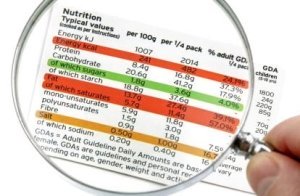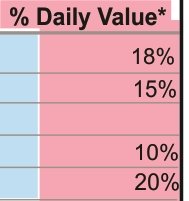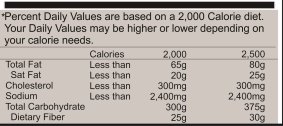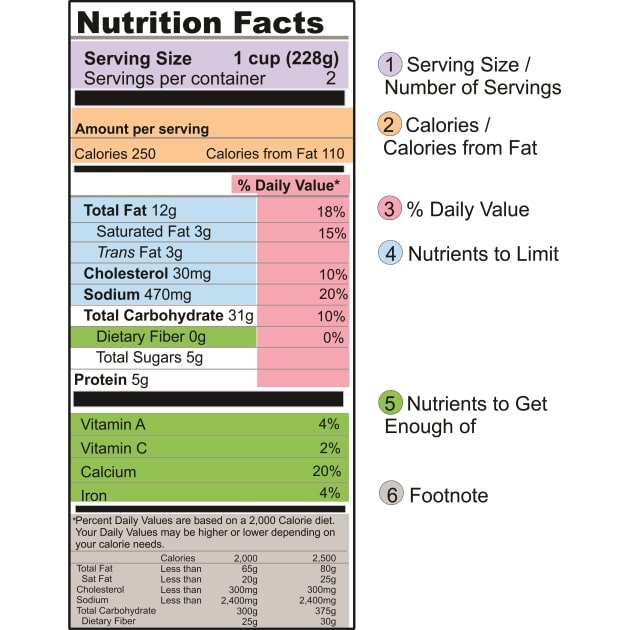How to Read Food Labels

Learning how to read food labels will go a long way to help you develop your healthy eating lifestyle.
Understanding the labels and interpreting the information will help you make sensible food selections at the grocery store and ensure you get the nutritional values you need.
With the labels, you will find the amounts and kinds of nutrients that are provided in the item.
It contains the information on calories, fats, sodium, fiber, protein and carbohydrates and more “per serving.” However, understanding and reading these labels can be very perplexing.
A typical consumer would definitely ask what those numbers mean and how it will affect their weight loss plan and healthy lifestyle.
%Daily Values(%DV)
This is perhaps one of the more confusing parts of food labels. The %DV is based on the daily recommended values for a particular nutrient based on a 2,000 a day calorie intake. The percent helps you judge if a food item is high or low in a nutrient like total fat, dietary fiber, etc.

The percentages do not add up to a total of 100% for that food item. Instead the percent shown is representative of that particular nutrient and how much that food item will supply you with the recommended daily amount for that nutrient.
For instance, the example food label shows 12g total fat. This means eating one serving of this food item uses up 18% of the total 100% of the recommended fat intake for the day.
Even if your daily calorie intake is less than or more than the 2,000 a day that these percentages are based on, you can still use these percentages to ensure you are getting enough of a particular nutrient. Likewise it can help you to minimize those nutrients you want to be careful not to exceed your daily limits.
Understanding the % Daily Values will help you make better selections at the grocery store and not fall into the “sales pitch” of certain food items. If an item says “reduced fat” you can compare the %DV of two like products to see exactly which one is lower in fat.
Just make sure the serving sizes are similar for the comparison.
Nutrients to Limit
When reading the food labels watch for the total fat (saturated and trans fat), cholesterol and sodium content. These are the first nutrients listed on the labels and are generally the nutrients we get an adequate amount of and often times too much of.
You want to try and limit these nutrients and ensure you do not go over the daily recommended amounts.
Nutrients You Want
The nutrients you want to ensure you get enough of include dietary fiber, Vitamin A & C, Calcium and Iron. Generally people do not always get the recommended daily amount of these nutrients.
Eating the right amount of these nutrients can improve your health and minimize certain medical risks. Calcium intake is important for the strength of your bones and dietary fiber helps with the bowel function.
Diets high in fruits and veggies, which are high in vitamins and dietary fiber, may reduce the risk of heart disease.
Understanding the Foot Notes
On the food label, the footnote that starts with the “*” is in reference to the % Daily Values listed above the footnote.

This is required on all food labels but the remaining portion of the footnote is not required and may not be on the package.
When the full footnote is shown it will always be the same. This footnote is the recommended dietary advice for all Americans and not specific to that food item.
This footnote on the food label will show the recommended amounts for both a 2,000 a day calorie diet and a 2,500 a day calorie diet.
As you can see from the footnote, the daily recommended amount for total fat is 65g for a 2,000 calorie intake and 80g for 2,500.
Upper Limits
The nutrients that list the upper daily limits are listed first and have “less than” associated with the calories column. This means your goal should be to consume less than the upper limit daily recommended amount.
Lower Limits
The nutrients that list the lower or minimum daily limits are listed last. The goal for these nutrients is to consume at least the recommended daily allowance amounts shown.
Ingredients
As you begin to read food labels you will also want to check out the list of ingredients. This will be located on the package but may not be located near or around the nutrition label.
Things to watch for in the ingredients are processed foods such as white flour, sugar, etc. The listing is arranged from the main ingredients that have the greater amount by weight up to the smallest quantity.This simply means that the actual quantity of the food includes the biggest quantity of the main ingredient or the first item and the minimum amount of the very last ingredient.
Label Claims
This refers to the kinds of nutritional claims of a particular food item. For instance, if an item says it is sodium-free, it has less than 5 milligrams per serving or a low fat item actually contains 3 grams of fat or less.
Additional Articles
Portion Sizes
Now that you have read "Food Labels Explained" make sure to read all
about proper portion sizes. Portion sizes are often unknown or blown out of portion. Knowing the
proper sizes can ensure you get in the right amount of foods.
Cutting
Calories
If you need to reduce your calorie intake for weight loss, then check
out these tips. Cutting calories can help ensure you reach your goals.
Foods
to Boost Metabolism
Check out these foods to rev up your metabolism and fuel your fat
burning furnace. Use these foods for a snack, add them to a recipe or order them while
eating out.






